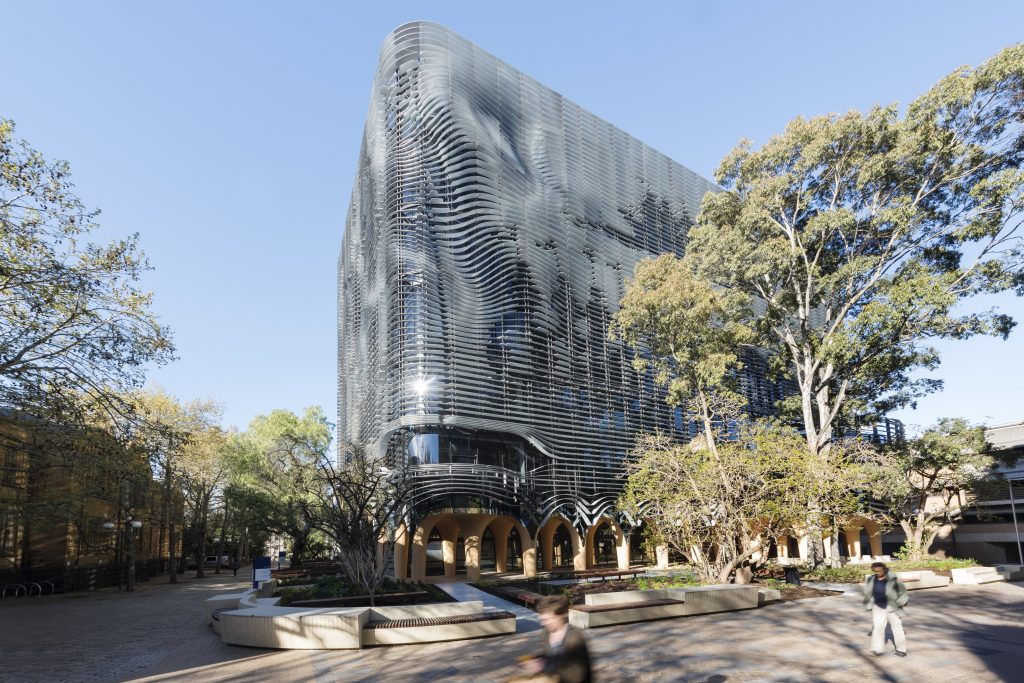Valmont Coatings Australia has won the Global Galvanizing Award for the University of Melbourne’s Arts West Building, together with ARM Architecture, Architectus and Fab Metal Specialists

The Global Galvanizing Award is presented by the European General Galvanizers Association (EGGA) every three years for outstanding hot-dip galvanized steel architecture.
According to Valmont Coatings Managing Director Aaron King, “With 36 projects submitted from 13 different countries, we are thrilled the project has taken out this prestigious international award.”
The $66 million Arts West Redevelopment Project was one of the University of Melbourne’s most significant infrastructure projects in recent years.
A major component of the Arts West Redevelopment project was the renovation of the university’s Faculty of Arts building.
The new building — constructed over seven levels on Professors Walk opposite the heritage Old Arts Faculty Building — provides the University’s Arts Precinct with a dedicated, high-quality teaching and learning environment.
ARM and Architectus worked with the University of Melbourne’s Faculty of Arts to tailor the building so that it reflects the latest pedagogical thinking as applied in the Faculty of Arts curricula.
In an era when campuses must offer something beyond online study, Arts West’s spaces are tailored to project-based collaborative, interactive, seminar, discursive and didactic modes of teaching and learning.
One of the most stunning and distinctive visual features of the new Faculty of Arts building is its louvered facade, which involved ground-breaking use of steel.
The building effectively has two skins: a glass wall and a structure of parallel horizontal steel fins or louvres — resembling deep exterior Venetian blinds.
The facade is both a passive solar-control element and an architectural manifestation of the Faculty of Arts.
The steel sections of each louvre were shaped so that they form a series of 3D images.
The images are ‘pressed’ into the facade and reveal themselves to viewers at different times of the day and from different viewpoints.
The images feature selected objects from the University of Melbourne’s 23 Cultural Collections.
According to King, the project team opted to galvanize the louvres to protect the steel from corrosion and add visual appeal.
“The fins on the facade serve two main purposes, to provide sun shading to the tall glass curtain wall behind and to house images of objects from the University’s Cultural Collections.
“The steel plate was laser cut in plan to form the negative relief of the images.
Unique approach
“Utilising steel for the purpose of sun shading is reasonably unique, as many buildings with a second skin use aluminium instead.
“Steel was chosen as it allowed us to use very thin steel, only 8mm, which performed well in shading the teaching spaces, but also allowed minimal interruptions looking out.”
“Galvanizing is — of course — a wonderful way to protect steelwork, but they also liked the mottled and crystalline effects that galvanizing provided.
“It will change over time, from a bright reflective material to a dull grey.
“Galvanizing provided the facade with the kind of raw surface that the project team was after,” King says.
Valmont Coatings coated 480 individual steel sections in zinc prior to their delivery to the University of Melbourne construction site.
Valmont Coatings’ plant in suburban Campbellfield, north of the Melbourne CBD, completed each batch of the galvanized steel louvres within an average turnaround of two to three working days in the plant.
Valmont Coatings is one of Australia’s largest hot-dip galvanizing companies and a recognised leader in protective metal coatings. Valmont Coatings currently operates eight sites across four Australian States.
According to King, “Galvanization provides a long lasting, tough, durable coating that provides complete corrosion protection both inside and out, in addition to enhancing the appearance.
“However, the choice of coating ultimately depends on what the client needs, plus galvanization is not appropriate for every situation.
“Asset owners need to consider initial cost, lifecycle costs, aesthetics and the environment when choosing a coating system.”
The hot dip baths at Valmont Coatings can accommodate pieces up to 12m in length, 1.8m wide and 2.7m deep.
“We can work with larger structures if they have been designed in sections that can be bolted together after galvanizing,” King said.
“Alternatively, if an object exceeds the dimensions of our zinc bath, it is possible to progressively or ‘double’ dip larger single pieces.”
With ten zinc kettles and over 350 employees Australia-wide, Valmont Coatings provides services to a diverse range of industries and is renowned for liaising with clients to provide the best solution for each project.
Their sectors of operation include commercial and residential construction, infrastructure, manufacturing, mining, oil and gas, and agriculture.
With galvanizing operations in south-east Asia, north America and Europe, Valmont has close to 1,000,000t of galvanizing capacity worldwide.
For more information, visit: http://www.valmontcoatings.com/locations/australia




